
Briefing: India’s energy and climate change challenge
Mat Hope
01.26.15Mat Hope
26.01.2015 | 11:45amThe US and India have signed a deal to “enhance cooperation” on cutting emissions and investing in low carbon energy sources. The countries agreed the deal during President Obama’s state visit to meet India’s prime minister Narendra Modi this weekend.
Last time the president visited one of the world’s foremost developing economies, China, he signed an historic deal on climate change. As the world’s third largest emitter, India is coming under increasing pressure to follow suit.
The new US-India pact is weaker than the agreement Obama signed in Beijing. But there are a number of good reasons India is reluctant to take strong action to curb its emissions in the short term.
Carbon Brief takes a look at the factors likely to shape India’s energy and climate choices in the coming years, and what it means for the world’s efforts to tackle climate change.

Infographic: What’s driving India’s energy and climate policies? By Rosamund Pearce for Carbon Brief.
Population and poverty
India has become noticeably more progressive on climate change under prime minister Narendra Modi. It remains adamant that the world’s developed economies must shoulder most of the responsibility for curbing emissions, however.
It has good reasons for this. More than 300 million people currently live in poverty in India. A similar number do not have access to electricity. Modi has made it his priority to address these related issues.
Over the past decade, India’s economy has been significantly outpaced by China. Its per capita GDP is now significantly below China’s, and remains a long way off the US’s:
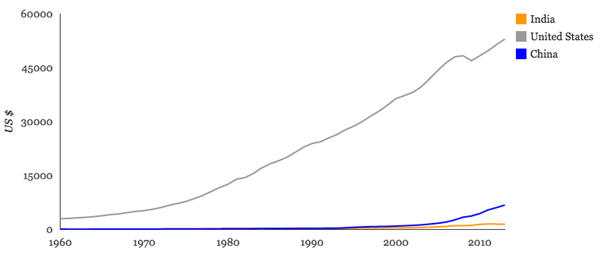
Source: World Bank. Graph by Carbon Brief.
That’s one reason India remains staunchly protective of its right to economic development. Modi was elected last May on a promise to prioritise the revival of India’s economy above all else.
This is only going to get more challenging as India’s population continues to boom. By 2028, India is expected to overtake China as the world’s most populated country, with 1.45 billion people:
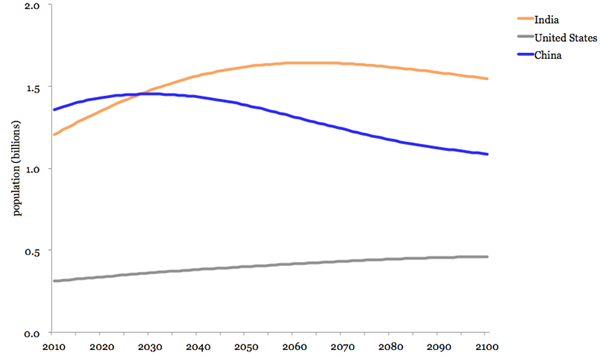
Source: United Nations Department of Economic and Social Affairs, mid-range projection. Graph by Carbon Brief.
Ensuring India’s ever-expanding population has reliable electricity will be integral to its economic development. It will also mean a big increase in the country’s energy demand. India’s energy consumption is expected to rise 132 per cent by 2035, while electricity demand is likely to more than triple in the next 30 years, according to some estimates.
That means making some major changes to its energy sector.
India’s energy sector
No one expects India to be able to meet such huge demand totally, or even mostly, with low-carbon energy sources. But that doesn’t mean India is going to single-handedly ruin the world’s efforts to cut emissions and tackle climate change.
India’s economy is currently heavily reliant on coal, and that’s unlikely to change any time soon. Last year, almost 60 per cent of India’s installed power plants were coal-based:
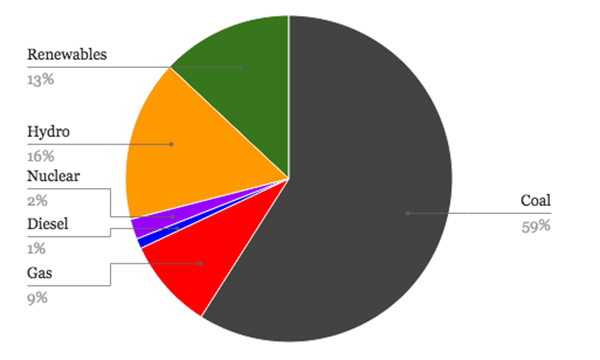
Source: EIA installed capacity. Graph by Carbon Brief.
Many models that assume the world will take some action to cut emissions and tackle climate change allow for this.
Under the IEA’s new policies scenario, where the world takes some action but misses its goal of preventing warming of more than two degrees, coal still accounts for 55 per cent of India’s electricity generation in 2040. And that’s assuming coal power plants become much more efficient in the meantime.
Such long-term reliance on coal explains one of the Modi’s government’s least climate friendly policies: supporting its domestic coal industry. The government aims to double India’s coal production to one billion tonnes by 2019. That’s mainly because India currently uses more coal than it produces, as this graph shows:
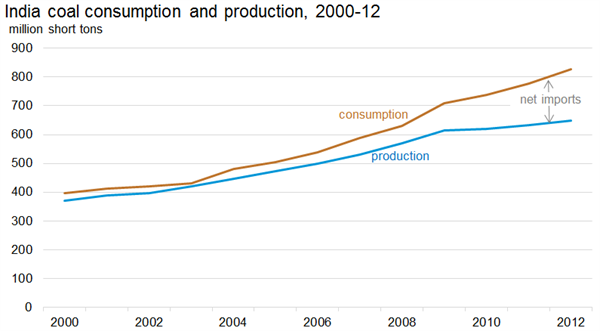
Source: EIA
That makes India heavily dependent on imports from Australia, Indonesia, South Africa and Canada. India’s energy minister Piyush Goyal in November announced a target of ending coal imports in the next two to three years, sending shockwaves through the industry.
The government argues that India needs to develop its domestic energy production for the good of the economy. That means tackling the red tape and corruption that currently hobbles India’s domestic coal production. But it also means ramping up renewables.
Modi’s manifesto promoted policies resembling US president Obama’s “all of the above” energy strategy, calling for the development of renewables and nuclear alongside gas and coal.
Wind power currently accounts for about 70 per cent of India’s renewable energy capacity, and the government wants to add 10,000 megawatts more each year. Modi also wants to try and scale-up the solar power-driven economic revival he instigated as Gujarat governor, adding 100 gigawatts nationwide by 2022. In the IEA’s new policies scenario, renewables increase their share of electricity generation from 15 per cent in 2014 to 26 per cent in 2040.
While India’s renewables sector is growing, it is nowhere near reaching its maximum potential, consultancy EY suggests. This graph shows the amount of capacity India could have if it maximised each technology’s potential. The dark segments show how much is already installed, the lighter segments show how much EY says India could add:
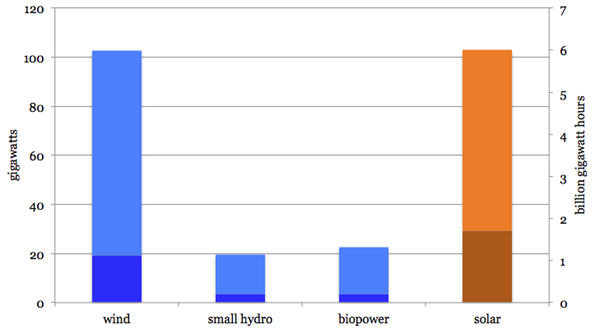
Source: EY. Graph by Carbon Brief.
As well as encouraging new industries and foreign investment, Modi hopes renewables can go some way to solving India’s electrification problem. He argues India’s rural communities may be better suited to the creation of renewables-based microgrids than joining India’s unreliable fossil-fuel based national grid. India’s grid currently loses about 23 per cent of its power during transmission through old wiring and theft.
But, despite the expected renewables boom, they are expected to only provide for about 16 per cent of India’s projected energy demand in 2040 overall. Fossil fuels are projected to account for 75 per cent.
That’s partly because lots of India’s increased energy demand will be for cooking and heating fuels, not just electricity.
Over 800 million Indians use cookstoves that burn dung, wood, or other solid fuels to generate heat, many of them in rural communities. As India’s population increases, demand for these fuels is set to rise. The fuels used in the cookstoves release lots of particulate matter and greenhouse gases, such as methane, contributing to air pollution, climate change and hundreds of thousands of deaths each year.
India’s government is trying to rollout a biogas cookstove programme to reduce the emissions from these stoves. Burning that less carbon-intensive fuel could prevent the emission of 0.5 to one billion tonnes of greenhouse gas, according to one study.
So India is planning ways to boost the low-carbon energy sector, it’s just going to do it while also trying to expand its fossil fuel base. Modi’s government is unabashedly technology neutral when it comes to upgrading India’s archaic energy infrastructure. If a technology drives economic growth and can provide citizens with an improved standard of living, Modi is willing to exploit it, regardless of its carbon intensity.
As a consequence, India’s energy-related emissions are set to more than double by 2040, the IEA suggests:
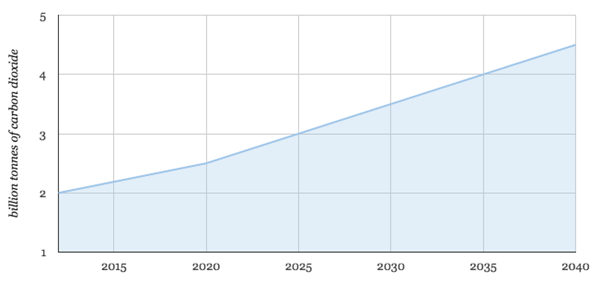
Source: Data from IEA World Energy Outlook 2014. Graph by Carbon Brief.
Emissions
That may sound like bad news for the world’s efforts to tackle climate change. But India recognises its emissions can not increase indefinitely.
The UK has said that it expects India’s emissions to grow in the near term, but to peak “around or shortly after 2030”. India is open to the idea of setting a peak emissions year, similar to China’s recent pledge, but wants its emissions to match China’s before curbing them some time between 2030 and 2050.
That date reflects the fact that India continues to see emissions reduction targets as the preserve of the rich. One reason India holds so dearly to the principle of “common but differentiated responsibilities” – the idea that the most developed countries must take the earliest and biggest steps to cut emissions – is because it is still a small contributor to the problem, once its population is taken into account.
India’s emissions from goods and services consumed within the country are only a fraction of those of their developed country counterparts. And the average Indian still emits much less carbon dioxide than people living in the US, Europe or even China:
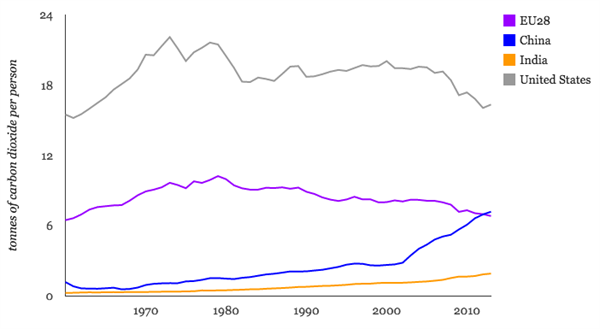
Source: Global Carbon Project. Graph by Carbon Brief.
The Daily Mail criticised Obama for leaving India “without inking a climate deal that formed much of the basis for his second trip to the subcontinent.” But India’s emissions, combined with its poverty, population and principles, meant Modi was never likely to agree to a climate deal similar to the US and China’s accord. In short, it is simply not ready, politically or economically, to accept such restrictions on its greenhouse gas emissions.
New deal
As expected, the new pact doesn’t include any firm commitment for India to curb its greenhouse gas emissions. Instead, Obama and Modi agreed a range of measures to help wean India off fossil fuels, and to cooperate in pursuing a new global climate deal.
The most headline grabbing announcement was that the the countries have reached a “breakthrough in understanding” on nuclear power. Foreign companies had been reluctant to invest in India’s nuclear industry over fears of being held liable in case of accidents.
India agreed to implement some new and still vague provisions to reduce such liability, including a new insurance pool. The mechanisms don’t require new legislation, meaning US energy companies are now more likely to consider investing in India.
In return, the US pledged up to $1 billion in clean energy financing. That funding expands on the $125 million Partnership to Advance Clean Energy Research programme supported by the US and Indian governments and the private sector.
The US also offered to work with India’s institutes to develop new climate resilience tools, including downscaling climate models to a higher resolution for the Indian subcontinent.
On the international climate negotiations, the US and India said in a joint-statement that both countries were “committed to working towards a successful outcome in Paris in 2015 of the conference of the UN Framework Convention on Climate Change, including the creation of a new global agreement on climate change.”
Referring to the Paris deal, Obama told a press conference:
“India’s voice is very important on this issue. Perhaps no country could potentially be more affected by the impacts of climate change and no country is going to be more important in moving forward a strong agreement than India.”
Expanding on India’s position in the international climate negotiations, Modi said:
“It is the responsibility of those, who are concerned about future generation, to become conscious about climate change and adopt policies so that we are able to give good future and good environment to next generation.”
While India continues to make encouraging noises around taking action to tackle climate change, the US-India pact is weaker than the one Obama signed in Beijing last year. That perhaps unsurprising, as the agreement broadly fits with Modi’s economic and energy plans and reflects India’s image of where it sits in the international climate negotiations.
Main image: Holi Festival of colour, Uttar Pradesh.
Updated 26/01/15: The details of the US and India's new agreement were added. Updated 28/01/15: The reference to the Daily Mail was added.

